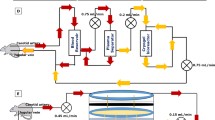Abstract
Although various types of artificial liver support systems (ALSSs) including a hybrid type have been made, few are practical ALSSs for treatment of acute and/or chronic hepatic failure. Titanium oxide (TiO2), a stable material, dismantles various materials using a photocatalytic action under ultraviolet irradiation. The aim of this study was to assess the effect of a new ALSS using TiO2. Hepatic failure plasma obtained from patients undergoing plasma exchange therapy due to acute liver failure was used in these experiments. The plasma was perfused using a closed circuit model with a column filled with TiO2. The plasma concentrations of total bilirubin, albumin, fibrinogen, interleukin (IL)-6, IL-8, and IL-10 were serially measured. We evaluated the photocatalytic effect of TiO2 irradiated with ultraviolet light. The effect of initial perfusion with fresh-frozen plasma (FFP) was also investigated, focusing on the decrease in fibrinogen during perfusion. Levels of total bilirubin decreased after perfusion using the column filled with TiO2, compared with no UV irradiation. The levels of IL-6, IL-8, and IL-10 decreased after perfusion using the TiO2 device. The albumin level was maintained at the initial level, however, the fibrinogen level decreased within 4 hr. Initial perfusion of the circuit with FFP improved the decrease in fibrinogen for up to 8 hr. Our new perfusion device using the photocatalytic action of TiO2 may be a promising ALSS.








Similar content being viewed by others
References
Dowling DJ, Mutimer DJ (1999) Artificial liver support in acute liver faolure. Eur J Gastroenterol Hepatol 11:991–996
Kjaergard LL, Liu J, Als-Nielsen B, Gluud C (2003) Artificial and bioartificial support systems for acute and acute-on-chronic liver failure. A systematic review. JAMA 289:217–222
Stocmann HBAC, Hiemstra CA, Marquet RL, Ijzermans JNM (2000) Extracorporeal perfusion for the treatment of acute liver failure. Ann Surg 231:460–470
Rozga J, Holzmann MD, Ro MS, Griffin WS, Neuzil DF, Demetriou AA (1993) Development of a hybrid bioartificial liver. Ann Surg 217:502–511
Yamazaki Z, Kamai F, Ideduki Y, Inoue N (1992) Extracorporeal methods of liver failure treatment. Biomater Artif Cells Artif Organs 15:296–299
Stange J, Mitzner SR, Klammt S, Freytag J, Peszynski P, Loock J (2000) Liver support by extracorporeal blood purification: a clinical observation. Liver Transplant 6:603–613
Byrne JA, Eggins BR, Brown NMD, Mckinney B, Rouse M (1998) Immobilisation of TiO2 powder for the treatment of polluted water. Appl Catal B Environ 17:25–36
Wang KH, Hsieh YH, Ko RC, Chang CY (1999) Photocatalytic degradation of wastewater from manufactured fiber by titanium dioxide suspensions in aqueous solution. Environ Int 25:671–676
Fujishima A, Cai RX, Otsuki J, Hashimoto K, Itoh K, Yamashita T, Kubota Y (1993) Biochemical application of photoelectrochemistry: photokilling of malignant cells with TiO2 powder. Electrochim Acta 38:153–157
Mills A, Hunte SL (1997) An overview of semiconductor photocatalysis. J Photochem Photobiol A 108:1–35
Fujishima A, Rao TN, Tryk DA (2000) Titanium dioxide photocatalysis. J Photochem Photobiol C 1:1–21
Pless G, Sauer IM (2005) Bioartificial liver: current status. Transplant Proc 37:3893–3895
Park JK, Lee DH (2005) Bioartificial liver system: current status and future perspective. J Biosci Bioeng 99(4):311–319
Naruse K (2005) Artificial liver support: future aspects. J Artif Organs 8:71–76
Demetrium AA, Brown RS Jr, Busuttil RW (2004) Prospective, randomized, multicenter, controlled trial of a bioartificial liver in treating acute liver failure. Ann Surg 239:660–670
Zhang AP, Sun YP (2004) Photocatalytic killing effect of TiO2 nanoparticles on Ls-174-t human colon carcinoma cells. World J Gastroenterol 10(21):3191–3193
Fausto N (2000) Liver regeneration. J Hepatol 32:19–31
Rodrigueez-Gaspar M, Santolaria F, Jarque-Lopez A, Gonzalez-Reimers E, Milena A, de la Vega MJ, Rodriguez-Rodriguez E, Gomez-Sirven TJL (2001) Prognostic values of cytokines in SIRS general medical patients. Cytokine 15:232–236
Guo LM, Liu JY, Xu DZ, Li BS, Han H, Wang LH, Zhang WY, Lu LH (2003) Application of molecular absorbent recirculating system to remove NO and cytokines in severe liver failure patients with multiple organ dysfunction syndrome. Liver Int 23 (Suppl 3):16–20
Stange J, Hassanein TI, Mehta R, Mitzner SR, Bartlett RH (2002) The molecular absorbent recirculating system based on albumin dialysis: a summary of preclinical investigation, prospective, randomized, controlled clinical trial, and clinical experience from 19 centers. Artific Organs 26:103–110
Wang YJ, Wang ZW, Lou BW, Liu HL, Wen HW (2004) Assessment of resin perfusion in hepatic failure in vitro and in vivo. World J Gastroenterol 10(6):837–840
Acknowledgments
This study was supported by a Grant-in-Aid for Scientific Research (Scientific Research: Exploratory Research, No.17659390). This study was presented in part at the 15th World Congress of the International Association of Surgeons and Gastroenterologists, Prague, September 2005.
Author information
Authors and Affiliations
Corresponding author
Rights and permissions
About this article
Cite this article
Shinohara, H., Shimada, M., Ikemoto, T. et al. New Type of Artificial Liver Support System (ALSS) Using the Photocatalytic Effect of Titanium Oxide. Dig Dis Sci 52, 2271–2275 (2007). https://doi.org/10.1007/s10620-006-9701-4
Received:
Accepted:
Published:
Issue Date:
DOI: https://doi.org/10.1007/s10620-006-9701-4




